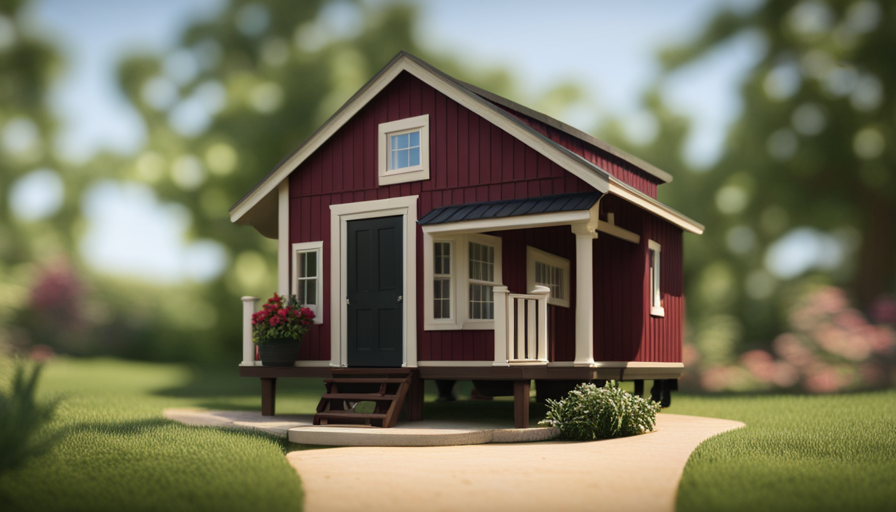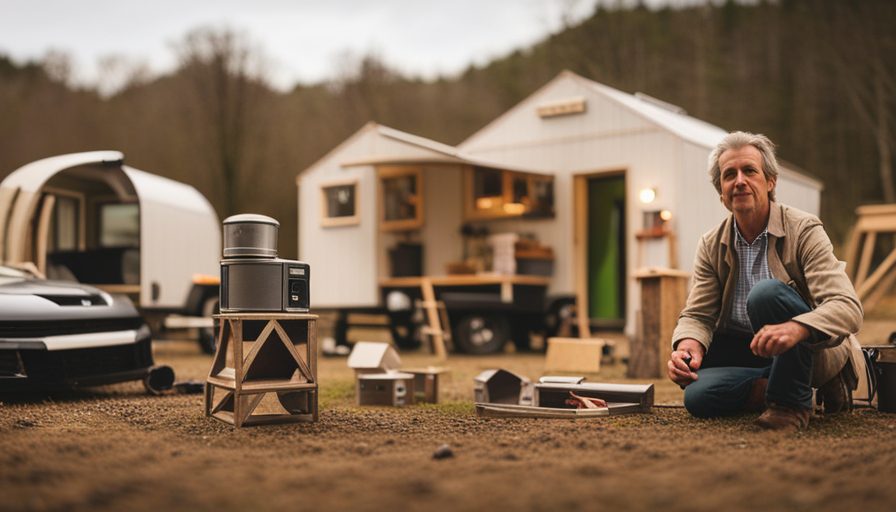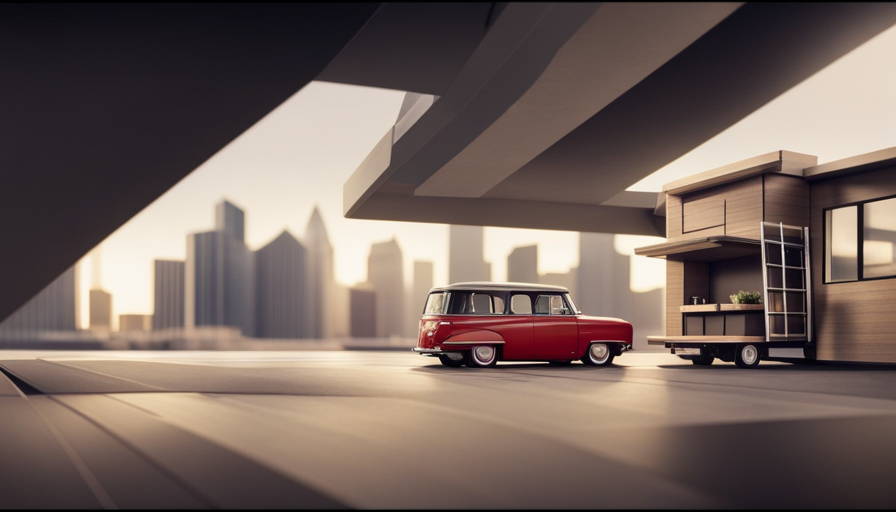Standing at the entrance of my small mobile home, I am filled with excitement at the countless opportunities that await me. It feels like I have opened a door to endless possibilities, where space becomes a canvas for creativity and freedom.
In this article, we will delve into the dimensions and size options of tiny house trailers, uncovering the secrets that lie within their compact frames. Whether you’re a minimalist seeking simplicity or an adventurer craving a nomadic lifestyle, understanding the basics of tiny house trailers is essential.
These trailers come in various sizes, ranging from 16 to 30 feet in length, with width options of 8 to 10 feet. Different types of tiny house trailers offer unique features and advantages, catering to diverse space needs and lifestyles. From designing and customizing your trailer to transporting and parking it, we will explore every aspect of this fascinating world.
Living in a tiny house trailer has its pros and cons, and we will weigh them carefully. So, buckle up and join me on this journey as we uncover the wonders of tiny house trailers and discover how big they truly are.
Key Takeaways
- Tiny house trailers come in various sizes, ranging from 16 to 30 feet in length and 8 to 10 feet in width.
- Different types of tiny house trailers have unique features and advantages, such as flatbed trailers and gooseneck trailers.
- Dimensions and weight capacity are important factors to consider when choosing a tiny house trailer, with length ranging from 12 to 30 feet, width from 7 to 8.5 feet, and weight capacity ranging from 7,000 to 23,000 pounds.
- Customization is important to suit individual needs, considering factors such as space needs and lifestyle preferences like sleeping, cooking, dining, storage, and bathroom facilities.
Understanding the Basics of Tiny House Trailers
Get ready to learn about the fundamentals of tiny house trailers and how they can make your dream of living in a compact space a reality!
Tiny house trailers are specifically designed to accommodate the unique needs of tiny homes. One of the most important factors to consider when choosing a tiny house trailer is its dimensions and weight.
These trailers come in various sizes, typically ranging from 16 to 30 feet in length and 8.5 to 9.5 feet in width. It’s crucial to ensure that the trailer you choose meets safety regulations and requirements, as it will serve as the foundation for your tiny home.
In the next section, we will explore the different dimensions and size options available for tiny house trailers.
Dimensions and Size Options
When it comes to tiny house trailers, the dimensions and size options are crucial factors to consider. The length, width, and height specifications determine how much space you have to work with and how comfortable your tiny home will be.
Additionally, the maximum weight capacity is important to know in order to ensure that your tiny house is safe and can be properly towed.
Length, Width, and Height Specifications
Measuring up like a pint-sized champion, the tiny house trailer boasts compact dimensions for length, width, and height specifications. When it comes to tiny house trailer dimensions, choosing the right trailer size is crucial to ensure a successful build.
The length of a tiny house trailer typically ranges from 12 to 30 feet, providing enough space for various floor plans and designs. Width options usually span from 7 to 8.5 feet, accommodating both narrow and wider structures. As for the height, it typically falls within the range of 10 to 13.5 feet, allowing for comfortable headroom. These dimensions offer flexibility for customization while adhering to transportation regulations.
Moving on to the next topic, the tiny house trailer’s maximum weight capacity plays a significant role in determining the materials and furnishings that can be included in the build.
Maximum Weight Capacity
To fully maximize your vision and create the perfect space, you’ll want to consider the impressive weight capacity of your mobile abode. Weight restrictions are an important factor to keep in mind when building a tiny house trailer. Exceeding the weight limits can compromise the structural integrity of the trailer, leading to potential safety issues during transportation. It is crucial to ensure that your tiny house trailer can handle the weight of your design, including furniture, appliances, and personal belongings. To help you understand the weight capacity of different tiny house trailers, I have provided a table below:
| Trailer Size (Feet) | Maximum Weight Capacity (Pounds) |
|---|---|
| 16-20 | 7,000-9,000 |
| 20-24 | 10,000-14,000 |
| 24-28 | 15,000-18,000 |
| 28-32 | 19,000-23,000 |
Considering these weight restrictions and the structural integrity of your trailer is essential to ensure a safe and functional tiny house on wheels. Now let’s explore the different types of tiny house trailers.
Different Types of Tiny House Trailers
If you’re looking for a cozy retreat on wheels, you’ll be amazed by the variety of tiny house trailers available to suit your unique style and needs.
When it comes to types of tiny house trailers, you have several options to choose from. One popular type is the flatbed trailer, which provides a solid foundation for your tiny home and allows for easy transportation. Another option is the gooseneck trailer, which offers additional stability and space for larger tiny homes.
In terms of materials, tiny house trailers are typically made from steel or aluminum, both of which provide durability and strength. Steel trailers are heavier but offer more stability, while aluminum trailers are lighter and more resistant to corrosion.
Considering your space needs and lifestyle, it’s important to choose the right type and material for your tiny house trailer to ensure a comfortable and secure living experience.
Transitioning into the next section, let’s now explore the importance of considering your space needs and lifestyle when designing your tiny home.
Considering Your Space Needs and Lifestyle
When designing your dream mobile retreat, it’s crucial to consider your unique lifestyle and space requirements. Space efficiency and minimalist living are key factors in making the most of your tiny house trailer. By carefully planning the layout and maximizing storage options, you can create a functional and comfortable living space.
To help you visualize the possibilities, here is a table showcasing some common space needs and how they can be accommodated in a tiny house trailer:
| Space Need | Solution |
|---|---|
| Sleeping | Loft bed or convertible sofa |
| Cooking | Compact kitchen with multipurpose appliances |
| Dining | Folding table or breakfast bar |
| Storage | Built-in cabinets and clever organization systems |
| Bathroom | Compact shower, toilet, and sink combo |
By considering these factors, you can design a tiny house trailer that suits your lifestyle while maximizing the available space. In the next section, we will explore the exciting possibilities of designing and customizing your tiny house trailer to make it truly your own.
Designing and Customizing Your Tiny House Trailer
Get creative and let your imagination run wild as you design and personalize your own mobile haven on wheels.
When it comes to customizing features for your tiny house trailer, the possibilities are endless. Consider your lifestyle and space needs to determine what features are essential for you.
Do you need a full kitchen or can you make do with a smaller cooking area? Will you need a separate sleeping loft or can you opt for a Murphy bed to maximize space?
Keep in mind your budget considerations as you choose materials and finishes for your trailer. Remember, every decision you make will impact the overall cost of your tiny house.
As you finalize your design, think about how you will transport and park your tiny house trailer.
Transporting and Parking Your Tiny House Trailer
Once you’ve finalized your design, you’ll need to consider how you’ll transport and park your mobile haven on wheels.
Transporting a tiny house trailer can present some unique challenges. The size and weight of the trailer can make it difficult to navigate through narrow streets or tight turns. You may need to hire a professional to transport your tiny house or invest in a truck with the appropriate towing capacity.
Additionally, finding parking spots can be a challenge, especially in urban areas where space is limited. Some cities have zoning regulations that restrict where you can park a tiny house. It’s important to research local laws and regulations before you hit the road.
Despite these transportation challenges, living in a tiny house trailer offers many benefits. It allows you to have a mobile lifestyle and the freedom to explore new places.
Pros and Cons of Living in a Tiny House Trailer
Imagine the freedom of waking up in a cozy, compact space that can take you on countless adventures. Living in a tiny house trailer offers a unique lifestyle with both pros and cons.
One of the biggest advantages is the opportunity to downsize and simplify your life. With limited space, you’re forced to prioritize and only keep what truly matters. This can lead to a more minimalist and clutter-free existence.
Living in a tiny house trailer can also have significant financial implications. The cost of purchasing and maintaining a tiny house is typically much lower than that of a traditional home. This can result in significant savings and increased financial freedom.
However, it’s important to consider the potential drawbacks. Limited space means you have to be creative with storage, and there may be challenges in finding suitable parking and access to utilities.
Despite these considerations, many people find that the benefits of living in a tiny house trailer far outweigh the drawbacks.
Frequently Asked Questions
Can I legally live in a tiny house trailer?
Living in a tiny house trailer can be a dream come true for many, but it’s essential to understand the legal aspects. When it comes to living legally in a tiny house trailer, there are regulations that vary depending on your location.
It’s crucial to research and comply with local building codes, zoning laws, and permit requirements. By doing so, you can ensure a safe and legal living experience in your tiny abode.
Are there any restrictions on where I can park my tiny house trailer?
There are several restrictions on where you can park your tiny house trailer, which are dictated by parking regulations and zoning laws. These regulations vary depending on your location, so it’s important to research and understand the rules in your area.
Some common restrictions include limitations on parking in residential areas, requirements for a permanent foundation, and minimum square footage requirements. It’s crucial to comply with these regulations to avoid legal issues and ensure a smooth and hassle-free living experience in your tiny house.
What are the average costs associated with owning and maintaining a tiny house trailer?
Owning and maintaining a tiny house trailer can be like tending to a delicate bonsai tree. It requires careful attention and nurturing.
The average maintenance costs vary depending on factors such as size, materials, and location. However, on average, you can expect to spend around $500 to $1,000 annually.
While the costs may seem low, it’s important to consider the pros and cons of owning a tiny house trailer, such as limited space, zoning regulations, and potential mobility challenges.
Can I build my own tiny house trailer or do I need to hire a professional?
To answer your question, you can either build your own tiny house trailer as a DIY project or hire a professional. However, it is crucial to consider building regulations before starting.
DIY projects offer flexibility and cost savings, but they require knowledge of construction and adherence to local regulations. Hiring a professional ensures expertise and compliance with building codes, but it can be more expensive.
It’s essential to weigh the pros and cons based on your skills, budget, and local regulations.
Are there any financing options available for purchasing a tiny house trailer?
Tiny house trailer financing options are available for those looking to purchase their own trailer. There are several options to consider, such as personal loans, RV loans, or even financing through tiny house manufacturers. These financing options can provide the necessary funds to buy a tiny house trailer without having to pay for it all upfront.
It’s important to research and compare different lenders to find the best terms and rates for your specific needs.
Conclusion
In conclusion, living in a tiny house trailer can be an incredibly rewarding and fulfilling experience. Not only does it allow you to simplify your life and reduce your environmental impact, but it also offers the freedom to travel and explore new places.
And here’s an interesting statistic that might surprise you: did you know that the average tiny house trailer is only about 8.5 feet wide? That’s smaller than the width of a standard parking space! It’s truly amazing how much can be accomplished in such a compact space.
Hi, I’m Emma. I’m the Editor in Chief of Tiny House 43, a blog all about tiny houses. While tree houses are often associated with childhood, they can be the perfect adult retreat. They offer a cozy space to relax and unwind, surrounded by nature. And since they’re typically built on stilts or raised platforms, they offer stunning views that traditional homes simply can’t match. If you’re looking for a unique and romantic getaway, a tree house tiny house might just be the perfect option.










